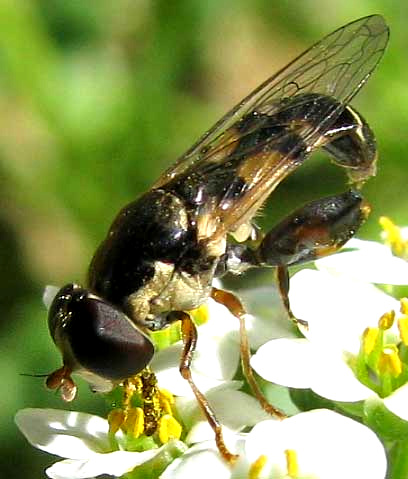Excerpts from Jim Conrad's
Naturalist Newsletter
from the September 6, 2009 Newsletter, issued from the Siskiyou Mountains west of Grants Pass, Oregon:
A DARK LITTLE HOVERFLY
Spotting a smallish, darker-than-I'm-accustomed-to-seeing hoverfly on Anita's Alyssums I snapped the shot shown below.

So, what's that dark, rice-grain-shaped thing emerging from the fly's side? Luckily I'd taken several pictures and one of them showed that the fly actually has two of them, as you can see below:

I was in a rush that day preparing for a hike so I shipped the images off to Bea in Ontario who very quickly responded that probably this was a SYRITTA PIPIENS, and that the elliptical things definitely are the fly's overgrown leg femurs! In the first picture the lower part of the leg is invisible but in the second the lower segments are clearer. I had to blush over that.
One English name for the fly is the Thick-legged Hoverfly. It's a member of the family Syrphidae, which holds a number of mostly yellow-and-black, stingless, hovering little flies generally known as flower flies and syrphid flies.
It turns out that male/female interactions in Syritta pipiens is as remarkable as that with the Sierra Dome Spider.
When males chase females they approach the female at a certain close distance but don't get so close that the females take evasive action. As the female leads the chasing male, the male always stays at exactly the same distance. Insect nervous systems react mostly to changes in size and movement, not to something that appears to be an unmoving spot, which is how the male looks to the female. The male's strategy employs a kind of "motion camouflage."
Moreover, if the female changes direction, the male flies sideways without changing his heading, which denies the female a chance to see the male with a different profile, from the side. No matter how the female flies, the male remains a same-size, same-shape speck behind her, and her eyes and brain just can't make anything of that.
Much more information is available at the Wikipedia Syritta pipiens page.
Syritta pipiens enjoys an enormous distribution, being native to the Palearctic region, which is one of Earth's eight biogeographic zones and embraces Europe, the northwest coast of Africa, and Asia north of the Himalayas. The species been introduced into North America; here Syritta pipiens is an invasive "weed species."